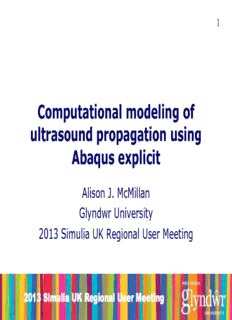
Computational modeling of ultrasound propagation using Abaqus explicit PDF
Preview Computational modeling of ultrasound propagation using Abaqus explicit
1 Computational modeling of ultrasound propagation using Abaqus explicit Alison J. McMillan Glyndwr University 2013 Simulia UK Regional User Meeting 2013 Simulia UK Regional User Meeting 2 Can Abaqus be used for wave and vibration problems? Absolutely! The beauty of finite element analysis is that • there is no restriction to special cases. It is useful to revisit the special cases: • Longitudinal waves - Transverse waves - Rayleigh waves - Waves in wave guides - Etc… - Because comparison of finite element results with these • can help with understanding and interpretation. 2013 Simulia UK Regional User Meeting 3 Ultra-sound as a method for Non Destructive Testing Ultra-sound is an acoustic wave with frequency above • the range of human hearing, about 20,000 Hz. For the NDT of engineering materials, the useful range • is 2 – 10×106 Hz, although for some lower density materials, the range 50 – 500×103 Hz is also used. Ultrasound NDT can be used to detect the presence of • sub-surface defects and thickness profiles of features. 2013 Simulia UK Regional User Meeting 4 Waves in solids Phase velocity of waves: Longitudinal • 𝐸(1 − 𝜈) 𝑐 = 𝐿 𝜌(1 + 𝜈)(1 − 2𝜈) Transverse • 𝐸 𝑐 = 𝑇 2𝜌(1 + 𝜈) Where a plane wave front impinges on a boundary, then • typically both a longitudinal and transverse reflection and transmission will take place. 2013 Simulia UK Regional User Meeting 5 Waves in solids Rayleigh waves Phase velocity • 0.862 + 1.14𝜈 𝑐 = 𝑐 𝑅 𝑇 1 + 𝜈 This wave travels along the free surface, with motion • perpendicular to the surface. Hopkinson’s bar – 1D wave guide: Used for measuring the stress-strain properties of • materials at high strain rate 𝐸 𝑐 = 𝜌 𝐵 2013 Simulia UK Regional User Meeting 6 Illustration – waves and vibrations in a beam Flexural waves in a Bernoulli-Euler beam The governing equation • 4 2 𝜕 𝑈 𝜕 𝑈 3 3 𝐸𝐼 + 𝜌𝐴 = 𝑞(𝑥, 𝑡) 𝜕𝑥4 𝜕𝑡2 Flexural rigidity, 𝐼 = 𝑤ℎ3 12 • Cross-sectional area, 𝐴 = 𝑤ℎ • Time dependent forcing term, 𝑞 𝑥, 𝑡 • Phase velocity is dispersive (velocity depends on • wavelength) 2𝜋 𝐸𝐼 𝑐 = 𝐹 𝜆 𝜌𝐴 2013 Simulia UK Regional User Meeting 7 Standing waves: Modal analysis Natural vibration modes are solutions of • 4 2 𝜕 𝑈 𝜕 𝑈 3 3 𝐸𝐼 + 𝜌𝐴 = 0 𝜕𝑥4 𝜕𝑡2 with boundary conditions encastre at one end and free at the other: 𝑈 𝑥, 𝑡 = 𝑎 𝑔 𝑥 sin(𝛼 𝑡) 3 𝑘 𝑘 𝑘 𝑘 𝑔 𝑥 = 𝐶 sin 𝑝 𝑥 − sinh 𝑝 𝑥 + 𝑅 cos 𝑝 𝑥 − cosh 𝑝 𝑥 𝑘 𝑘 𝑘 𝑘 𝑘 𝑘 𝑘 𝑝 are the roots of cos 𝑝 𝐿 + 1 cosh 𝑝 𝐿 = 0 𝑘 𝑘 𝑘 with 𝛼 = 𝐸𝐼 𝜌𝐴 (𝑝 𝐿)2 and 𝑎 = 𝑔 (𝐿) (𝜌𝐴𝛼 ) 𝑘 𝑘 𝑘 𝑘 𝑘 2013 Simulia UK Regional User Meeting 8 Data used in this exercise Aluminium properties Young’s modulus 70×103 MPa • Poisson’s ratio 0.35 • Density 2.7×10-9 Tonnes/mm3 • Beam geometry Length 100 mm • Width 10 mm • Thickness 2 mm • FEA model information Element type C3D8R, with • Model comprising 40 by 10 by 10 elements • 2013 Simulia UK Regional User Meeting 9 Modal analysis solutions 165 Hz 1032 Hz 2885 Hz 2013 Simulia UK Regional User Meeting 10 Low frequency forced motion Quasi-static Applied forcing frequency << lower than the • fundamental natural frequency The disturbance is transmitted through the component • far quicker than the forced movement at the loading point Analysis run time is slow in Explicit analysis: more • computationally efficient and no less rigorous to use an implicit analysis step 2013 Simulia UK Regional User Meeting
Description: